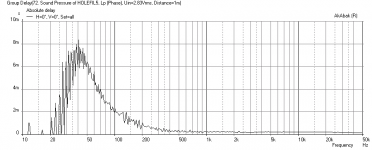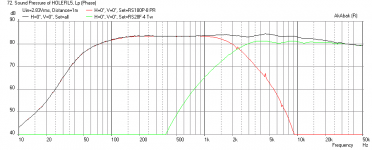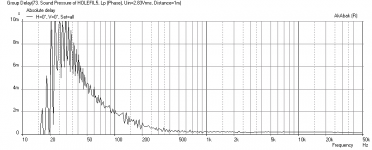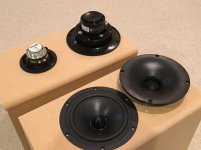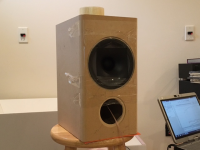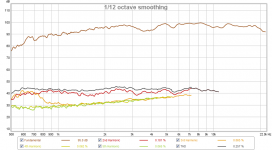Zvu,
Thanks for tip on Kimmo's approach. Very clever.
I still need to fill mine with latex caulking to absorb vibrations to reduce HD.
Thanks for tip on Kimmo's approach. Very clever.
I still need to fill mine with latex caulking to absorb vibrations to reduce HD.
I just realized my choice of round waveguide and 6.5in bass driver sort of looks like Amphion One18's. They use a passive radiator on the back I think.
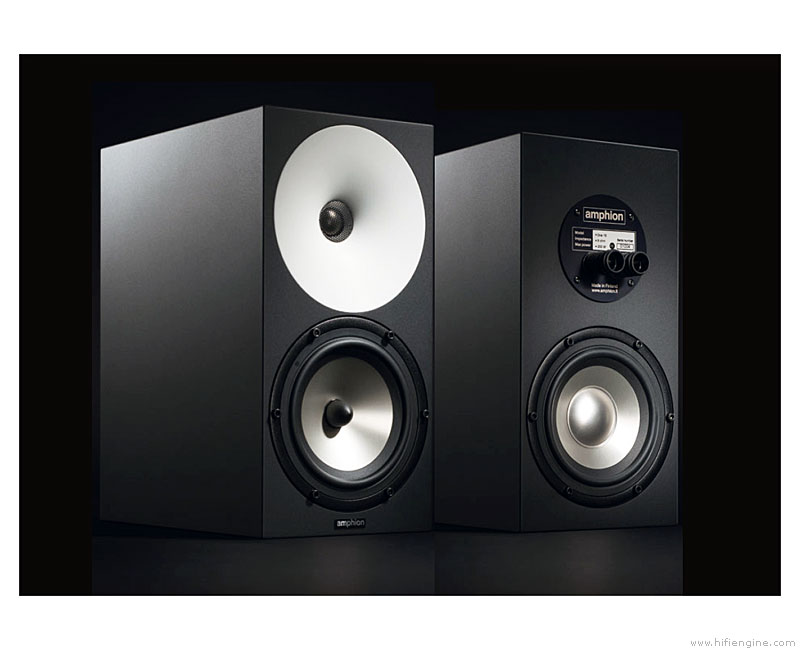
Amphion squeezes quite a bit of bass down to 45Hz according to their factory curve:
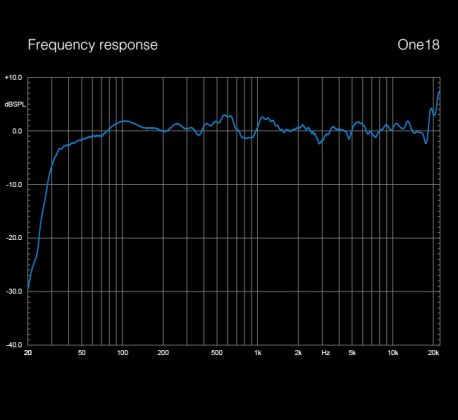
I could use a low cost woofer like a DC200-8 as a passive radiator (just because I have it already). Here is how it models - it avoids having a resonance peak out high from the vented option:
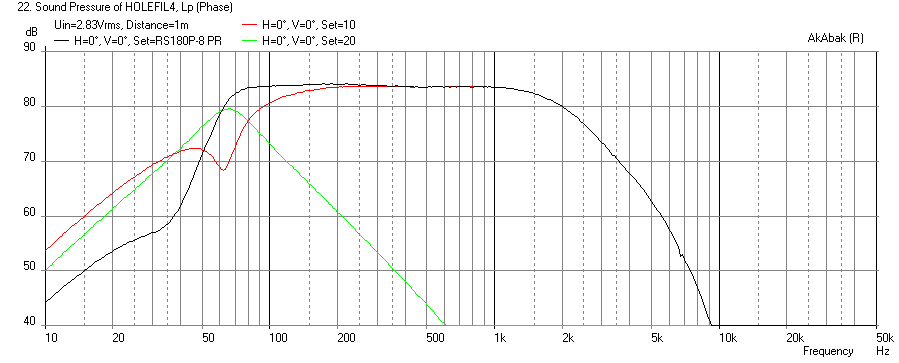
Here is the vented option, both should be able to get an F3 of about 60Hz:
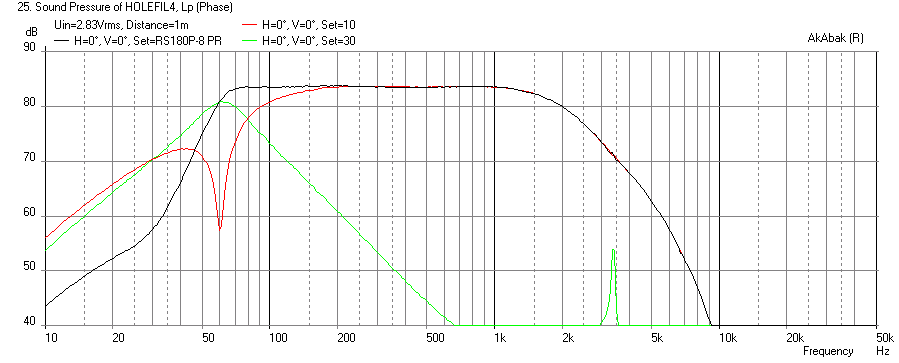
Here is all three drivers firing:
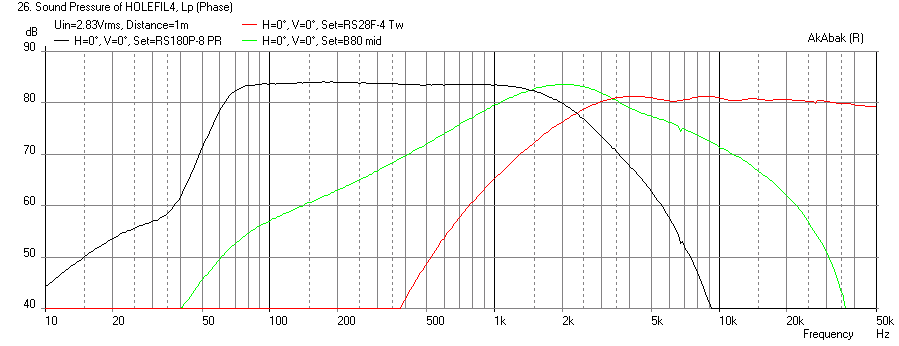
Here is the "hole" without the B80 mid:
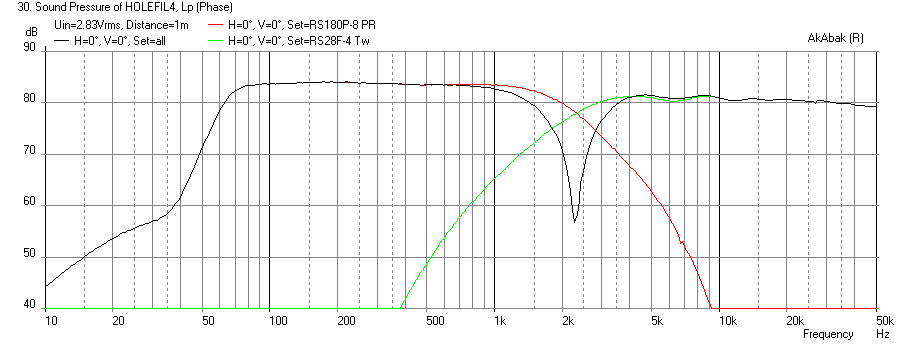
Here is the "hole" filled in with the B80:
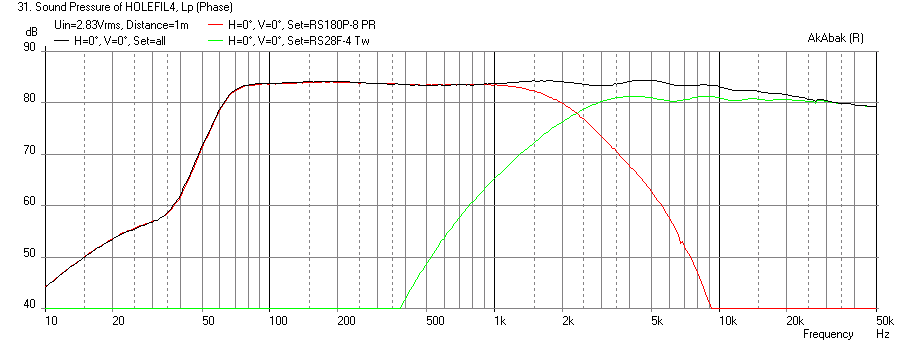
Here is the time-aligned IR with a passive radiator (it's rare to see a 3-way reflex speaker with an impulse response that is this tight and clean):
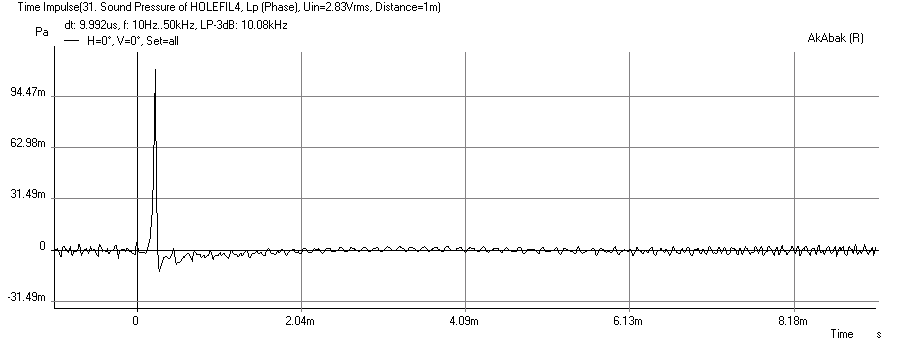
I suppose if I went to a premium woofer like a Revelator or an SB Acoustics Satori, I might be able to get deeper bass. However, I have to imagine all that bass comes at the expense of pretty high harmonic distortion and sloppiness. Tradeoffs I guess...

Amphion squeezes quite a bit of bass down to 45Hz according to their factory curve:

I could use a low cost woofer like a DC200-8 as a passive radiator (just because I have it already). Here is how it models - it avoids having a resonance peak out high from the vented option:

Here is the vented option, both should be able to get an F3 of about 60Hz:

Here is all three drivers firing:

Here is the "hole" without the B80 mid:

Here is the "hole" filled in with the B80:

Here is the time-aligned IR with a passive radiator (it's rare to see a 3-way reflex speaker with an impulse response that is this tight and clean):

I suppose if I went to a premium woofer like a Revelator or an SB Acoustics Satori, I might be able to get deeper bass. However, I have to imagine all that bass comes at the expense of pretty high harmonic distortion and sloppiness. Tradeoffs I guess...
Attachments
-
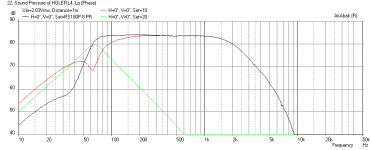 Boxes-RS28F-RS180P-B80-PR-sim.png26.2 KB · Views: 985
Boxes-RS28F-RS180P-B80-PR-sim.png26.2 KB · Views: 985 -
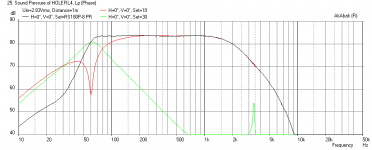 Boxes-RS28F-RS180P-B80-BR-sim.png11.6 KB · Views: 979
Boxes-RS28F-RS180P-B80-BR-sim.png11.6 KB · Views: 979 -
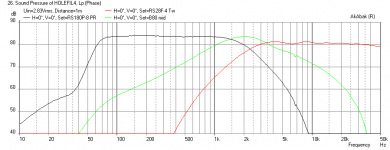 Boxes-RS28F-RS180P-B80-PR-XO.png25.7 KB · Views: 1,001
Boxes-RS28F-RS180P-B80-PR-XO.png25.7 KB · Views: 1,001 -
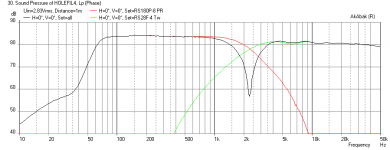 Boxes-RS28F-RS180P-B80-PR-Hole.png10.4 KB · Views: 985
Boxes-RS28F-RS180P-B80-PR-Hole.png10.4 KB · Views: 985 -
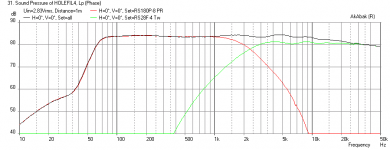 Boxes-RS28F-RS180P-B80-PR-Hole-Filled.png10.5 KB · Views: 933
Boxes-RS28F-RS180P-B80-PR-Hole-Filled.png10.5 KB · Views: 933 -
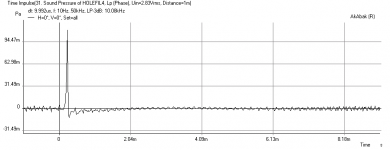 Boxes-RS28F-RS180P-B80-PR-Hole-Filled-IR.png7.2 KB · Views: 991
Boxes-RS28F-RS180P-B80-PR-Hole-Filled-IR.png7.2 KB · Views: 991
Last edited:
Looking good X - don't know how I missed this!
Will be interesting to see what you think about this type of speaker in comparison to the other designs you have made over the years!
I have experimented with transient designs and crossovers - minidsp makes this so easy, and I still think the polar response and freq response is much more influential than phase, so I will be very interested to see whether you think the design goals of this project - phase as the most important consideration - results in a better speaker than those you have done with other goals top of the list (i.e. constant directivity etc).
Will be interesting to see what you think about this type of speaker in comparison to the other designs you have made over the years!
I have experimented with transient designs and crossovers - minidsp makes this so easy, and I still think the polar response and freq response is much more influential than phase, so I will be very interested to see whether you think the design goals of this project - phase as the most important consideration - results in a better speaker than those you have done with other goals top of the list (i.e. constant directivity etc).
Good to hear from you again Bushmeister! This is a relatively new thread so not surprised you did not see it.
I am shopping for passive radiators now and think maybe two 6.5in PR's on the back may just be the ticket vs one 8in on the side. It keeps the box much stiffer and puts the bass energy coming out the back mostly.
These might just be ideal:
Dayton Audio SD175-PR 6-1/2" Passive Radiator
I am shopping for passive radiators now and think maybe two 6.5in PR's on the back may just be the ticket vs one 8in on the side. It keeps the box much stiffer and puts the bass energy coming out the back mostly.
These might just be ideal:
Dayton Audio SD175-PR 6-1/2" Passive Radiator
Using two of the SD175-PR passive radiators, I am able to extend the bass extension more gradually with a shallow fall-off so that the group delay is only 6ms at 50Hz. This should should a lot better for transients. Ultimate bass impact may not be as hard but overall balance should be better.
Here is frequency response with hole filler mid turned on and dual PR's active:
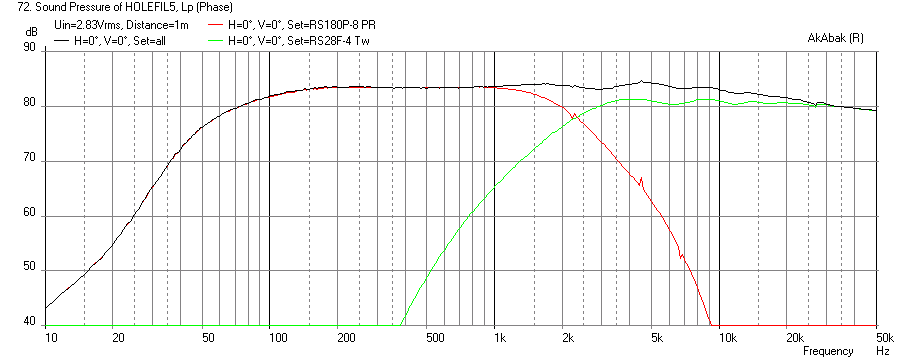
Here is group delay of the dual PR with 10grams added mass :
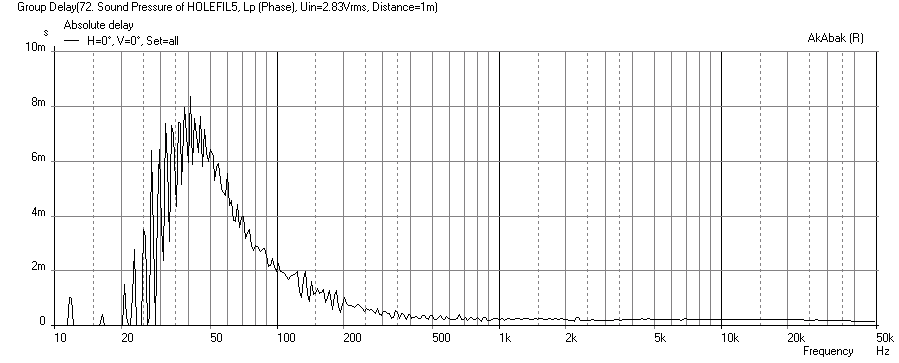
With 50 grams added mass, the FR looks like this:
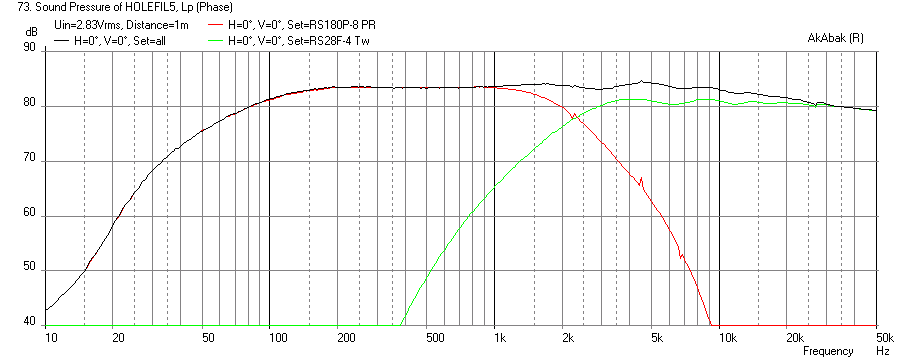
And the GD at 50Hz is about 4ms now:
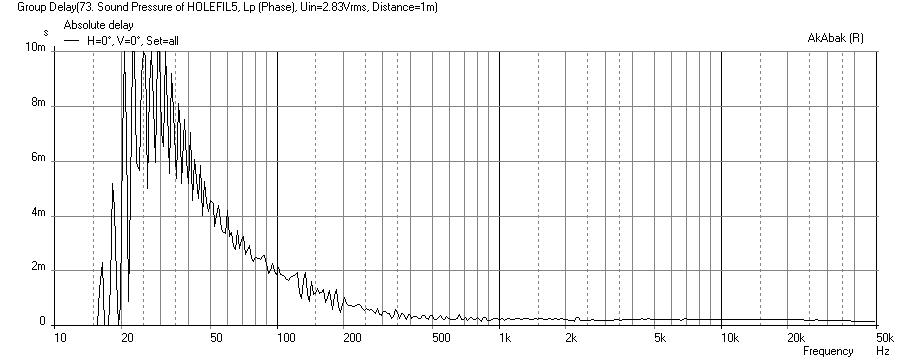
Here is frequency response with hole filler mid turned on and dual PR's active:

Here is group delay of the dual PR with 10grams added mass :

With 50 grams added mass, the FR looks like this:

And the GD at 50Hz is about 4ms now:

Attachments
Last edited:
If you'd use DC200-8 woofer as passive radiator, you could add damping resistor across its terminals.
Last edited:
You can also configure the network across the woofer terminals as a C-R, to add frequency-dependence to the damping. Wire a pair of banana sockets to the woofer terminals, and no switch will be needed.
Nice project, xrk (similar to what me and some friends have been working on). Hope it turns out well!
Nice project, xrk (similar to what me and some friends have been working on). Hope it turns out well!
That's s cool idea Jcarr. I see you are in Japan making stylus bodies - nice looking products there. I ordered passive radiators because really want to rear mount them. I suppose I could have ordered budget 6.5in woofers for the task.
Both waveguide assemblies now completed and ready for mounting. I ended up using a ring of putty to make the interface between the WG and the 3d adapter plate air-tight. The interface between the tweeter faceplate and the adapter are sealed with the tweeter's pre-cut foam rubber gasket. This is needed to prevent blow by from the woofer going through the waveguide output and modulating the tweeter dome.
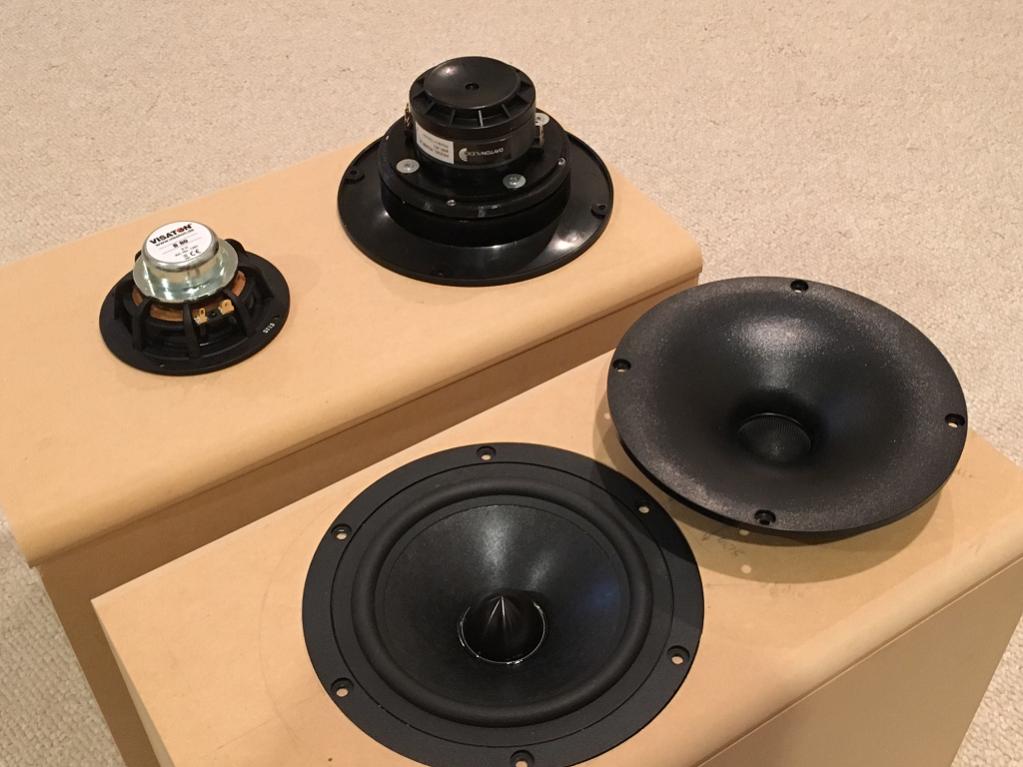
Despite the fact that the B80 mid will be on a separate mini baffle on top with room for time alignment via translation back and forth, I think I will need to give it a small waveguide as well - sort of like a round-over waveguide just to boost the output a bit. According to the simulations, a 3-way hole filler with one frequency for all filters (HP for woofer, LP for tweeter and LP and HP for mid) will cause a substantial attenuation to the mid amplitude due to the shallow 1st order slopes applied to the mid. In fact we know what this is by definition a 1st order filter is defined by the -3dB point at the filter frequency. In this case, a band pass with both centered on the XO frequency will cause a -6dB peak attenuation on the mid. One way around this is to space the XO so that it is defined by a lower and higher frequency window rather than a singular point.
Why do I want one frequency only? I want to make a flexible system that can run as a 2-way when I need a compact system by removing the mid upper unit and flipping phase on tweeter. In fact, I will design the XO at first around a 2-way with non-absolute phase impulse response (conventional symmetric LR2 2 way speaker). It will have a sharp hole at XO when both in phase, then add the filler mid for times when you want absolute phase correct and the best possible transients in a transient perfect time aligned system.
Or another way is to use a mid with higher sensitivity - which could also be another possibility. The overall sensitivity of the system is defined by the woofer minus baffle step. Assuming worst case open air (4pi steradian positioning) we have -6dB from 89.5dB or 83.5dB. B80 sensitivity is 85dB nominal and -6dB from bandpass filters puts it at 79dB. To get up to 83.5dB will require a waveguide to bring it up by 4.5dB. But acording to the hole filler theory, a little more is needed on the mid to really fill in so maybe +5dB gain is what I need. This now seems pretty complicated. I could design and model a small WG for the B80 and 3d print it and make it a combined WG and front trapezoidal baffle in one unit which would be kind of cool. Or I can use a higher sensitivity mid. The only one I know that can solve this would be the Faital Pro 3FE22 with 91dB sensitivity. That would actually be the perfect match. So I have some thinking to do in tradespace. The B80 sounds better and has superb waterfall characteristics.
Sort of seeing why a speaker like this hasn't been commercially made yet. Complicated.

Here are specs of B80:
http://www.visaton.com/pdfexport/de/servicestr.form?pid=/pdfexport/pdf/b80_8.html
Here are specs of 3FE22:
http://www.parts-express.com/pedocs/specs/294-1101-faitalpro-3fe22-8-specifications.pdf

Despite the fact that the B80 mid will be on a separate mini baffle on top with room for time alignment via translation back and forth, I think I will need to give it a small waveguide as well - sort of like a round-over waveguide just to boost the output a bit. According to the simulations, a 3-way hole filler with one frequency for all filters (HP for woofer, LP for tweeter and LP and HP for mid) will cause a substantial attenuation to the mid amplitude due to the shallow 1st order slopes applied to the mid. In fact we know what this is by definition a 1st order filter is defined by the -3dB point at the filter frequency. In this case, a band pass with both centered on the XO frequency will cause a -6dB peak attenuation on the mid. One way around this is to space the XO so that it is defined by a lower and higher frequency window rather than a singular point.
Why do I want one frequency only? I want to make a flexible system that can run as a 2-way when I need a compact system by removing the mid upper unit and flipping phase on tweeter. In fact, I will design the XO at first around a 2-way with non-absolute phase impulse response (conventional symmetric LR2 2 way speaker). It will have a sharp hole at XO when both in phase, then add the filler mid for times when you want absolute phase correct and the best possible transients in a transient perfect time aligned system.
Or another way is to use a mid with higher sensitivity - which could also be another possibility. The overall sensitivity of the system is defined by the woofer minus baffle step. Assuming worst case open air (4pi steradian positioning) we have -6dB from 89.5dB or 83.5dB. B80 sensitivity is 85dB nominal and -6dB from bandpass filters puts it at 79dB. To get up to 83.5dB will require a waveguide to bring it up by 4.5dB. But acording to the hole filler theory, a little more is needed on the mid to really fill in so maybe +5dB gain is what I need. This now seems pretty complicated. I could design and model a small WG for the B80 and 3d print it and make it a combined WG and front trapezoidal baffle in one unit which would be kind of cool. Or I can use a higher sensitivity mid. The only one I know that can solve this would be the Faital Pro 3FE22 with 91dB sensitivity. That would actually be the perfect match. So I have some thinking to do in tradespace. The B80 sounds better and has superb waterfall characteristics.
Sort of seeing why a speaker like this hasn't been commercially made yet. Complicated.

Here are specs of B80:
http://www.visaton.com/pdfexport/de/servicestr.form?pid=/pdfexport/pdf/b80_8.html
Here are specs of 3FE22:
http://www.parts-express.com/pedocs/specs/294-1101-faitalpro-3fe22-8-specifications.pdf
Attachments
Last edited:
Speaker with wave guide loaded mid and tweet:
Avantgarde Acoustic Zero 1 Pro Loudspeaker | The Absolute Sound
Avantgarde Acoustic Zero 1 Pro Loudspeaker | The Absolute Sound
Yes, I have seen those - very nice but in quite a different size class. Very large CTC spacing and all DSP and not passive. Are they even trying for transient perfect?
Pretty big boxes with W x H x D dimensions at 490 x 1040 x 318 mm.
XO points: 30 – 250 Hz, 250 – 2.000 Hz, 2.000 – 20.000 Hz
They are claiming very good impulse response (through FIR filters?):
ZERO 1 by Avantgarde Acoustic
XO points: 30 – 250 Hz, 250 – 2.000 Hz, 2.000 – 20.000 Hz
They are claiming very good impulse response (through FIR filters?):
ZERO 1 by Avantgarde Acoustic
Last edited:
Looks like it's going to be a very nice amp-testing setup 🙂. Won't the CC spacing become too large with a waveguide for the B80?
I will probably truncate (conform tweeter to woofer bezel and flat edge bottom of mid WG) the WG's on both the tweeters and mids to get tighter CTC spacing.
All this sort of reminds me of why putting it all in a point source horn a la synergy makes so much sense. A flat front baffle with separate WG's is in some ways, a bit more complicated that a single WG with mid and bass injection ports.
Yes, it was my intention to have this as a speaker for testing my amps in addition to just plain old listening to music.
All this sort of reminds me of why putting it all in a point source horn a la synergy makes so much sense. A flat front baffle with separate WG's is in some ways, a bit more complicated that a single WG with mid and bass injection ports.
Yes, it was my intention to have this as a speaker for testing my amps in addition to just plain old listening to music.
Pretty big boxes with W x H x D dimensions at 490 x 1040 x 318 mm.
XO points: 30 – 250 Hz, 250 – 2.000 Hz, 2.000 – 20.000 Hz
They are claiming very good impulse response (through FIR filters?):
ZERO 1 by Avantgarde Acoustic
Do they show it to support their claims? 🙂
A firm like Grimm Audio even tell us their idea behind it. Just mentioning it in advertising is meaningless for me. Using it like that and it becomes just another trendy word to sell something.
http://www.grimmaudio.com/site/assets/files/1088/speakers.pdf
Last edited:
When companies don't show graphs they are hiding something or they are aimed at a market that doesn't really know how to interpret read them and are just using buzzwords. Although I think this particular speaker if it is fully DSP and FIR'd there is no reason why they can't get a good flat response with transient perfect time.
Last edited:
Test of RS28F and WG-300
As a quick test, I taped the RS28F and WG-300 assembly into the cutout for the RS180P just so I could take some initial measurements. I used a 10uF 250v MKT film cap in series to block DC and using the Ranchu/Aksa quasi MOSFET amp with CS4398 DAC.
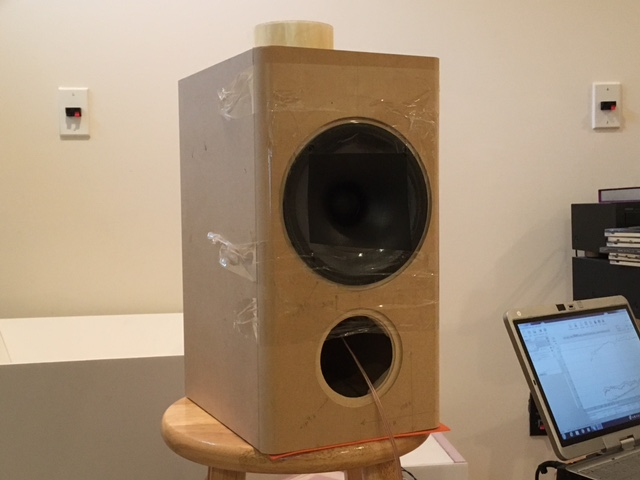
Here is the rough polar (+/-5 deg by eye) showing the performance of the WG and relative to the same RS28F mounted flush in same cabinet in the B80 cutout. Measurements at 0.5m.
There is a curious 5dB dip at 3.7kHz in the waveguide. That corresponds either a 0.9in 1/4-wave or 1.8in 1/2-wave reflection cancellation somewhere. It might be the small discontinuity between the WG throat and the tweeter bezel. The no WG curve at 0 deg does not have that dip but then shows a rising response. I will have to sort out that little dip.
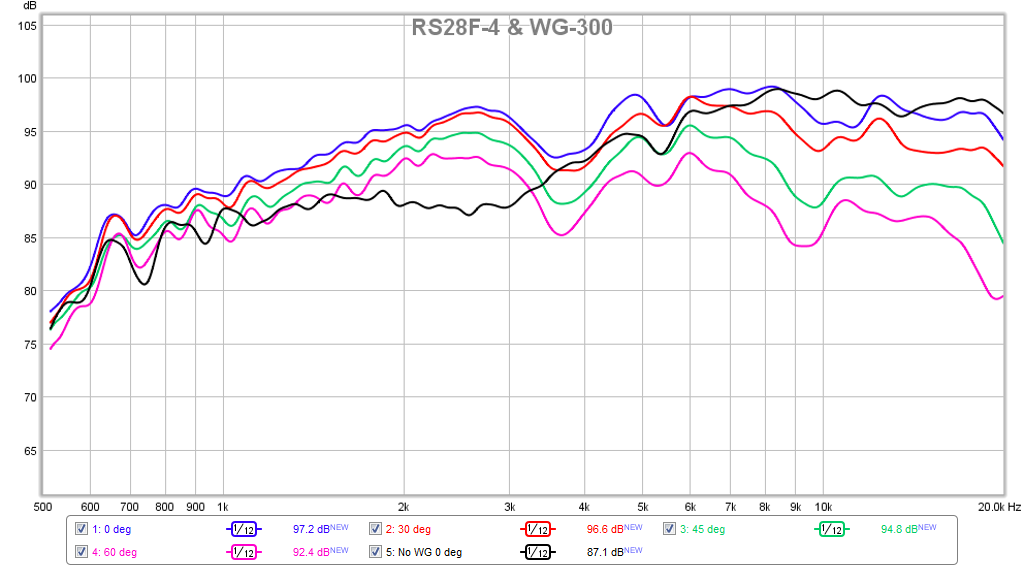
Here is the distortion, it's very low for this tweeter:
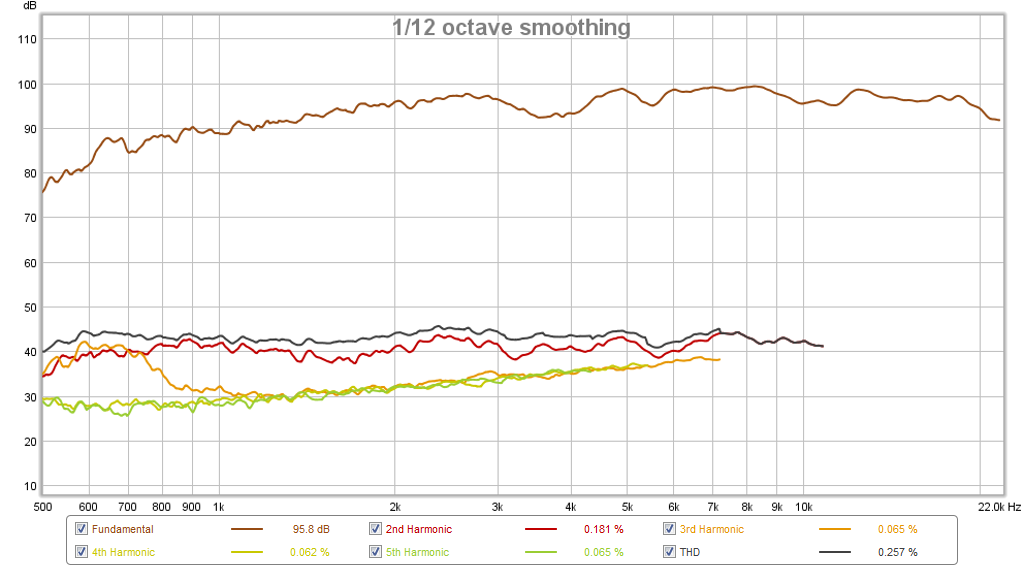
As a quick test, I taped the RS28F and WG-300 assembly into the cutout for the RS180P just so I could take some initial measurements. I used a 10uF 250v MKT film cap in series to block DC and using the Ranchu/Aksa quasi MOSFET amp with CS4398 DAC.

Here is the rough polar (+/-5 deg by eye) showing the performance of the WG and relative to the same RS28F mounted flush in same cabinet in the B80 cutout. Measurements at 0.5m.
There is a curious 5dB dip at 3.7kHz in the waveguide. That corresponds either a 0.9in 1/4-wave or 1.8in 1/2-wave reflection cancellation somewhere. It might be the small discontinuity between the WG throat and the tweeter bezel. The no WG curve at 0 deg does not have that dip but then shows a rising response. I will have to sort out that little dip.

Here is the distortion, it's very low for this tweeter:

Attachments
The smallest CTC distance that is practicable is 6.5in between the RS28 waveguide and the RS180P woofer. That's already with 0.5in cut out of the WG rim. What is the highest crossover frequency I can use given this distance? I calculate a fundamental wavelength of 2070Hz but to avoid inference cancelation aren't we supposed to aim for half this frequency? That would make a 1kHz xo which is way too low for any normal 2 way speaker cabinet. So maybe the xo needs to be below 2kHz is the rule of thumb? I might be just perfect or maybe push down to 1.7kHz just to be safe.
Does anyone have an idea where the 3.7kHz dip is coming from? Or is this normal and to be expected from a waveguide line this?
Does anyone have an idea where the 3.7kHz dip is coming from? Or is this normal and to be expected from a waveguide line this?
- Home
- Loudspeakers
- Multi-Way
- RS28F-RS180P-B80 as Hole Filler 3-way
